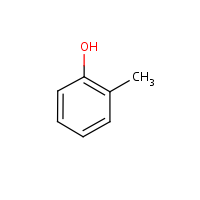o-Cresol
Agent Name
o-Cresol
Alternative Name
2-Methylphenol
CAS Number
95-48-7
Formula
C7-H8-O
Major Category
Other Classes

Synonyms
1-Hydroxy-2-methylbenzene; 2-Cresol; 2-Hydroxy-1-methylbenzene; 2-Hydroxytoluene; 2-Methylphenol; Orthocresol; Phenol, 2-methyl-; o-Cresol; o-Cresylic acid; o-Hydroxytoluene; o-Kresol [German]; o-Methylphenol; o-Methylphenylol; o-Oxytoluene; o-Toluol; Cresol, o-; Cresol, o-isomer; Cresol, ortho-; [ChemIDplus] 2-Hydroxy-1-methylbenzene; ortho-Hydroxytoluene; [ICSC] OCRE; [NTP] UN2076; UN3455
Category
Phenols
Description
Solid or liquid with a phenolic odor; Darkens with age and exposure to light and air; mp = 30 deg C; [Merck Index] Colorless solid; [ICSC] Colorless, yellow to yellowish-brown, or pink liquid; [CAMEO] White powder; [Sigma-Aldrich MSDS]
Sources/Uses
Used to make synthetic resins; Also used as an industrial solvent and in disinfectants and fungicides; [Merck Index] Used to make herbicides, pesticides, dyes, drugs, antioxidants, perfumes, and other chemicals; Also used as a food antioxidant, textile scouring agent, surfactant, metal cleaner, and ore flotation agent; Exposure may occur in the explosives, petroleum, photographic, paint, and agricultural industries; [HSDB] Used primarily as an intermediate; Other uses for o-cresol and cresol mixtures include cleaning compounds, degreasers, paints and paint strippers, adhesives, fiber treatment, wood preservatives, and cutting oils; [OECD SIDS: o-Cresol] Used as flavoring agent or adjuvant; [FDA]
Comments
Causes burns; Inhalation may cause pulmonary edema; Short-term exposure may have effects on the CNS (lowering of consciousness) and blood (destruction of blood cells); Prolonged or repeated exposure may have effects on the nervous system (impaired functions) and blood (anemia); Can be absorbed through skin; [ICSC] May cause second degree skin burns after a few minutes contact; Effects of chronic exposure may include CNS damage, chronic gastritis, heart and brain lesions, and liver and kidney injury; [CHRIS] More toxic than the m-isomer and less toxic than the p-isomer; May cause skin sensitization; [HSDB] Safe when used as a flavoring agent in food; [JECFA] Causes burns; Inhalation may cause corrosive injuries to upper respiratory tract and lungs; Highly toxic by inhalation; Toxic by ingestion and skin absorption; Targets the CNS, lungs, liver, kidney, pancreas, spleen, and cardiovascular system; [Sigma-Aldrich MSDS] See "Cresol, all isomers." See "o-Cresol" and "p-Cresol."
Reference Link #1
Biomedical References
Exposure Assessment
Skin Designation (ACGIH)
Yes
TLV (ACGIH)
20 mg/m3, inhalable fraction and vapor
PEL (OSHA)
22 mg/m3
Vapor Pressure
0.299 mm Hg
Odor Threshold Low
0.26 ppm
Odor Threshold High
0.65 ppm
Lethal Concentration
LC50 (rat) > 1,220 mg/m3/1hr
Explanatory Notes
Odor threshold low (detection) and high (recognition) from CHRIS; The Guide in the Emergency Response Guidebook is for "Cresols."
NFPA
high ambient temp required
Adverse Effects
Anemia
Hemolytic anemia
Toxic Pneumonitis
Yes
Methemoglobinemia
MetHgb is secondary toxic effect
Hepatotoxin
Hepatoxic (a) from occupational exposure (secondary effect) or (b) in animal studies or in humans after ingestion
Dermatotoxin
Skin burns
ACGIH Carcinogen
Not Classifiable
Diseases, Processes, and Activities Linked to This Agent
Processes
Industrial Processes with risk of exposure: